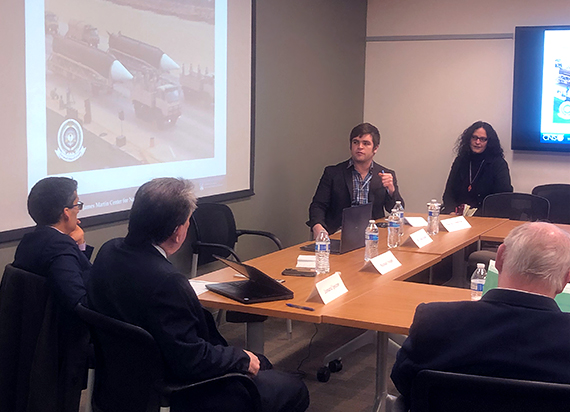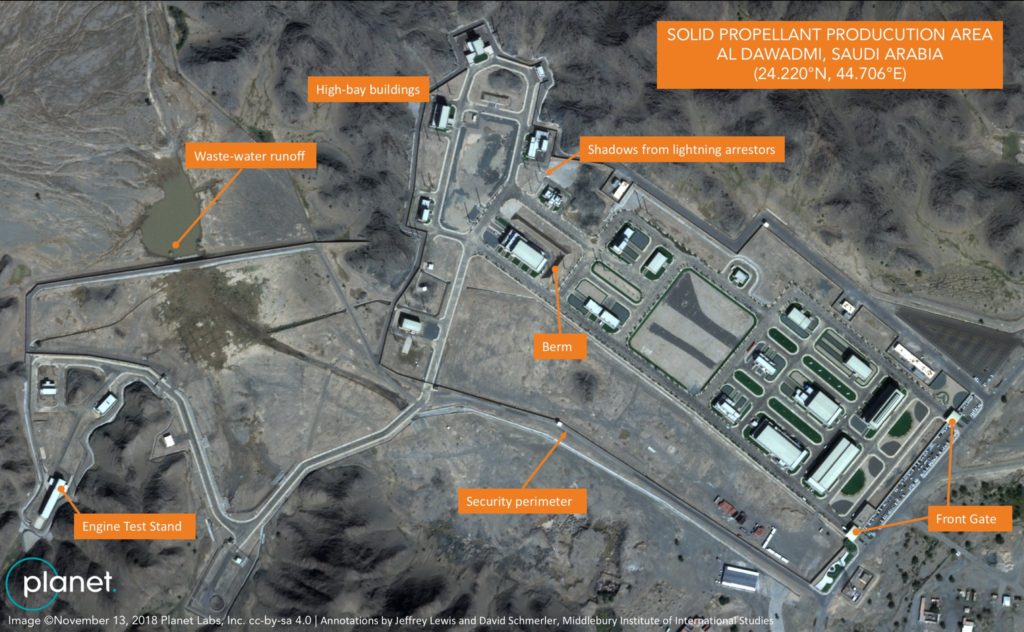March 26, 2019
Jamie Withorne
The James Martin Center for Nonproliferation Studies (CNS) held a policy briefing panel at the CNS DC office on March 4, 2019, to discuss the current geopolitics of the Kingdom of Saudi Arabia (KSA) and the surrounding region, the status of the KSA’s nuclear-energy program, and the implications on the KSA’s future nuclear plans in relation to the recent open-source satellite imagery analysis showing what seams to be a KSA solid-fuel missile test site.
The panel included Michael Singh, the Lane-Swig senior fellow and managing director at the Washington Institute for Near East Policy; David Schmerler, senior research associate at CNS; and Dr. Chen Kane, director of the Middle East Nonproliferation Program at CNS. Participants discussed Middle East security dynamics, the motivations behind the Saudi nuclear program, and its effects on United States foreign policy. Mr. Schmerler also spoke about the logistics of satellite-imagery analysis and the potential foreign policy and nonproliferation implications of this emerging application.
Four Developing Geopolitical Trends
Mr. Singh reviewed four developing geopolitical trends in the Middle East region that are particularly relevant to countries aspiring to build missile arsenals. The first trend relates to regional perceptions of US retrenchment and withdrawal from the region. Mr. Singh noted the growing sense in the region that the United States has become unpredictable and unreliable, citing the 2011 withdrawal of troops from Iraq, increased diplomatic engagement with Iran under the Barack Obama administration, and a general disinclination to involve US troops in Syria. US withdrawal from the region significantly affects allies’ independent security calculus by shifting their focus from internal security concerns to external threats. This is particularly relevant for countries such as the United Arab Emirates (UAE) and the KSA, and their respective involvement in regional conflicts, such as the current situation in Yemen. US allies in the region are increasingly concerned with how to best secure their flanks pending US retrenchment, a concern that has led to increased Saudi and UAE interventionism.
The second trend relates to the new and ambitious leadership in the area. KSA is the most obvious example of this trend, particularly as advanced by Crown Prince Mohammad bin Salman. Bin Salman has clearly portrayed himself to be a determined leader in the region, and is seeking to build a Saudi-centric regional-security system and to enhance the KSA’s role on the global stage. In tandem with this new style of leadership, there have also been rising levels of nationalism that are replacing older ideologies, including Islamist orientations.
Third is the trend of collapsing states and the regional power vacuums left in their wake. This trend dates back to 2011 and the Arab Spring, and has not only increased overall insecurity of the region, but has also created opportunities for US adversaries by influencing the foreign policy and regional strategy of said collapsed states. Changes are often solidified by cutting deals or forming relationships, rather than building a firm security toolkit, demonstrating that these governments are neither unitary nor stable. Especially concerning is their willingness to engage with non-state and sub-state actors.
Lastly, Mr. Singh spoke about the technological advances in the region. Excluding Israel, Iran is the most aggressive in its pursuit of cutting-edge technology, particularly nuclear and missile technologies. Iran has made significant strides in developing unmanned aerial vehicles, cyber capabilities, and space launch vehicles, surpassing other rivals in the region, who have felt more “comfortable” pursing conventional strategies. Mr. Singh stressed that there is a tripartite competition in the region between an Iranian-led bloc (including Syria and sub-state proxies), US allies, and a political Islamist block (Turkey/Qatar). This competition is paired with regional interventionism unprecedented in scale. Given this context, he argued that, without internal and/or external diplomacy to limit technological advances—such as the negotiations that led to the Iran deal—an open-ended arms race would develop in the region, each country attempting to match the others’ capabilities.
Facility for Producing Solid Fuel for Missiles
Following Mr. Singh’s presentation, Mr. Schmerler discussed CNS’s discovery, based on recent open-source satellite-imagery, of what appears to be a Saudi facility for producing solid fuel for missiles. As an introduction to Mr. Schmerler’s presentation, Rich Leshner first provided background on his company, Planet Labs, which provides the images. Planet Labs is a commercial and remote-sensing lab based in California, with the mission of providing a global data source that can improve transparency and the quality of evidence-based analysis and decision making. Planet Labs operates multiple constellations of satellites that conduct earth remote sensing at both medium and high resolutions, covering the entire land surface of the Earth every day. Mr. Schmerler analyzes 3-meter resolution imagery from Planet on a daily basis. He noted that the constant supply of images from Planet has fundamentally changed the way analysts monitor sites of proliferation concern, as it provides a persistent macro-view of activity at those sites. This is particularly useful for missile-engine/motor testing sites, since imagery can often show ground scars that appear after a test has taken place.
Mr. Schmerler discussed the specific site of al-Watah, a Saudi complex located south of Riyadh. Although the site was constructed in 2013, within the last six months, the CNS team found indicators of potential indigenous solid-fuel material production at the site that were not previously identified. The Saudi government has not acknowledged these recent developments.
The imagery Mr. Schmerler presented showed two different suspected areas within al-Watah—a larger area presumed to be for missiles production and a smaller area presumed to be for missile motor testing. Because solid fuel is highly explosive, production and testing sites have a distinctive appearance, i.e., signatures. Specifically, within the production area at al-Watah, both berms and lightning arrestors are clearly visible. These features are likely in place to protect against accidental explosions and redirect energy from a possible lightning strike. Additionally at al-Watah, there is a sizeable concrete extension separate from the potential production area. The horizontal positioning of the test stands is similar to solid-fuel test stands in other states—such as at China’s Xian test site. Although there is insufficient data to conclusively prove direct collaboration on the construction of al-Watah, the similarities to other known solid-fuel production and test sites, together with KSA-China trade history—including in missiles—raise concerns. Despite the site being covered—which limits the ability to monitor activity there—the team of CNS researchers have observed sporadic vehicle movement around the site. The limited number of vehicles observed there suggests that the site might not be completely operational, though Mr. Schmerler believes completion may be soon, adding the caveat that most types of imagery analysis cannot show nighttime activity.
The US government has been silent regarding the discovery, and it has yet to make any public statements or take any action. Mr. Schmerler noted that open-source analysts might not pay the closest attention to US partners and allies, even when these states may be participating in potentially destabilizing activities. Mr. Schmerler concluded by emphasizing the importance of taking regional context into consideration when conducting these open-source analyses.
KSA’s Nuclear Program
To conclude the briefing, Dr. Kane spoke about KSA’s nuclear program. Noting that the United States and KSA have been holding discussions on a bilateral nuclear-trade agreement to provide the foundation for the sale of US-manufactured nuclear power plants to KSA, she reviewed the economic, strategic, military, and nonproliferation motivations for US interest in the Saudi nuclear program. Any nuclear-trade agreement, she noted, must satisfy the legal requirements of section 123 of the US Atomic Energy Act, which sets standards regarding US nuclear cooperation with other states. Once negotiated, an agreement must come to Congress for a 90-day review period, during which a majority vote of the House and Senate can reject it, although such a disapproval must be signed by the president to be effective. Still, strong opposition from Congress can lead an agreement to be withdrawn or renegotiated. In the Saudi case, Congress might raise objections due to weak restrictions preventing the misuse of US exports, concerns about the Kingdom’s commitment to nonproliferation, or external considerations, such as its human rights practices, the Saudi role in Yemen, and stability of the country. Dr. Kane also noted that a 123 agreement is required for exporting reactors and major components, with less restrictive requirements for other items and technologies. She also noted that, although not required by Section 123, US practice since the mid-1990s has been to deny reactor sales to countries that have not signed an Additional Protocol with the International Atomic Energy Agency, which strengthens the organization’s authority to conduct inspections to ensure a country’s nuclear activities are exclusively peaceful. The KSA has not signed this instrument.
The current status of the Saudi National Atomic Energy Project, Dr. Kane noted, includes four components: large nuclear power plants, small module reactors, nuclear fuel cycle, and a national nuclear safety regulatory body. Dr. Kane stated that the nuclear fuel cycle is of most concern to US nonproliferation efforts, because the full fuel cycle would include facilities that can produce the essential materials needed to manufacture nuclear weapons.
Dr. Kane then discussed potential Saudi motivations behind developing a nuclear-energy program, namely the pursuit of energy and water security through diversification of energy sources and suppliers. She also discussed potential economic benefits, including an increase in fossil-fuel exports, as nuclear plants could reduce the need to use Saudi oil for domestic electricity production or desalination. Other motivations could include: pollution reduction, prestige, regional leadership, and a nuclear-weapon “hedging” strategy. The last is of greatest concern to the United States, since a nuclear-energy program with enrichment capabilities could simultaneously provide Saudi Arabia access to energy but also a path to acquiring an indigenous nuclear-weapon capability. Dr. Kane also highlighted a potential discrepancy between the Saudi stated goals of building nuclear power plants and actual construction plans, which include the number of reactors as well as their locations, as well as security concerns related to protecting nuclear power plants from potential missile strikes.
To conclude, Dr. Kane discussed nonproliferation measures that the US administration and Congress should consider before moving forward with an agreement. The most salient will be Saudi adoption of the Additional Protocol, Saudi renunciation of indigenous enrichment and reprocessing capabilities (which can provide access to weapons-usable nuclear materials), or at least Saudi arrangements for obtaining and returning nuclear fuel/spent fuel from foreign suppliers, which would eliminate the need for sensitive fuel-cycle facilities.
In conclusion, Dr. Kane stated that any Saudi nuclear program must have clearer objectives, an independent regulatory body, and be more transparent.


